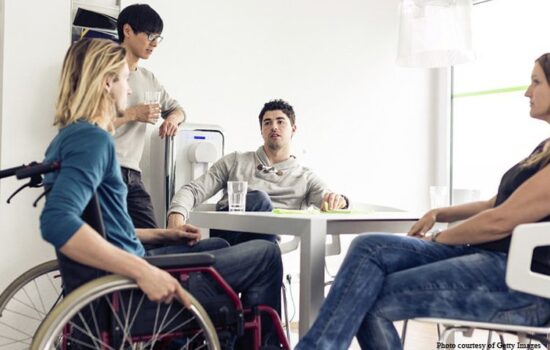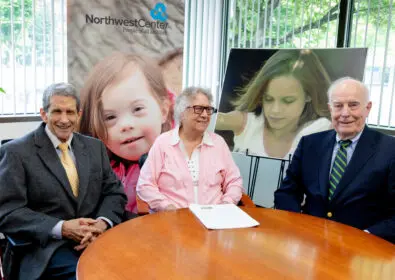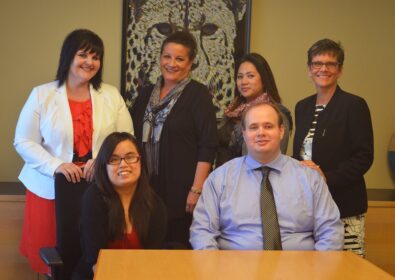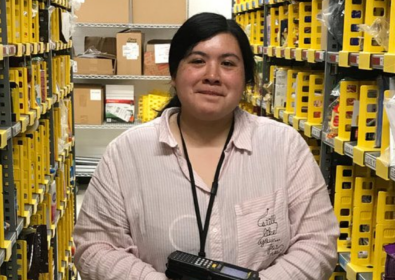

Making Your Workplace More Inclusive For People With Disabilities

atural Supports may be environmental such as a digital clock, a posted schedule, or labels on items and locations. These items assist employees with learning their routines and not being dependent on others for help or information. The goal of any employment relationship is to have the employee as integrated into the environment as possible. This goal is no different with an employee who happens to have a disability.
Other Natural Supports are personal associations and relationships typically developed within the community that enhance stability and quality of life. These relationships include: family, friendships, co-workers, and associations developed through participation in clubs, organizations, and other civic activities. One goal for Natural Support is for an employee to develop relationships on the job where they can be trained, have their questions answered, and feel supported to be successful.
People First Language – Use It
All people face social challenges. Very often, individuals are only associated with their label, appearance, or diagnosis. People with disabilities are a diverse group with innumerable skills, ideas, perspectives, and gifts to offer the world. When a label is used to define an individual or group of individuals, their true potential is often overlooked. People First Language always puts the individual in front of their diagnosis, emphasizing the fact that a person is not defined by their disability, but by their personality, skills, and interests.
Examples of People First Language:
Say: “Paul has a cognitive disability (diagnosis).” Instead of: “He’s mentally retarded.”
Say: “Kate has autism (or a diagnosis of).” Instead of: “She’s autistic.”
Say: “Ryan has Down syndrome (or a diagnosis of).” Instead of: “He’s Down’s; a Down’s person.”
Say: “Bob has a physical disability (diagnosis).” Instead of: “He’s a quadriplegic/is crippled.”
Say: “Mary uses a wheelchair/mobility chair.” Instead of: “She confined to/is wheelchair bound.”
Say: “Steve receives special education services.” Instead of: “He’s in special ed.”
Say: “Congenital disability.:” Instead of: “Birth defect.”
Say: “Brain injury.” Instead of: “Brain damage.”
Effective Communication Strategies
If your workplace is going to effectively include people of all abilities, supervisors and co-workers need to be able to communicate effectively. Likewise, if your company is going to offer a high-quality service to your customers or clients with disabilities, all of your employees need to have a basic level of comfort and understanding about how to effectively communicate with a diverse range of people. Some conditions are visible and readily apparent, people with mobility impairments often use wheelchairs, or other assistive devices. Other conditions are invisible, such as deafness, mental illness, and autism.
Hearing Impairments: range from a slight to severe or total loss. Communication methods will vary. The person may rely on amplification and lip reading, sign language, or a combination of these methods.
• If the person relies on sign language and an interpreter isn’t available, communicate by paper and pencil.
• If the person can communicate without an interpreter, face the person and speak slowly and clearly.
• If the person is communicating through an interpreter, speak directly to the person, not the interpreter. Maintain eye contact with the person even if he or she is looking at the interpreter.
• If the person has difficulty understanding something you’ve said, try repeating the phrase. If your message is still not understood, try to rephrase your thought rather than repeating the same words, or jot the phrase down on paper.
Vision Impairments: are divided into two general categories — total loss of sight and low vision. The following tips will vary depending on the person’s level of vision.
• When you approach the person, identify yourself and others with you by name. The person may not always recognize you by your voice; use verbal cues to let the person know when you arrive or leave the area.
• If you offer to guide the person, let the person take the back of your arm just above the elbow. Walk in a relaxed manner.
• When giving directions, use specific directional words, such as “straight ahead” or “forward.” Refer to positions in terms of clock hands: “The chair is at your 2 o’clock.” Avoid vague terms such as “over there.”
Speech Impairments: range from slight to severe, and the impairment may be related to another disability, such as cerebral palsy, a brain injury, or hearing loss.
• If the person’s speech is difficult to understand, politely ask the person to repeat or rephrase. You may find it helpful to ask questions that require short answers or a nod of the head.
• If you do not understand what the person is saying, let the person know. If you continue to have difficulty, offer pen and paper if the person is physically able to write. Asking the person to rephrase the thought or spell out a particular word may help.
Autism: a neurological condition that affects the functioning of the brain. Although the effects of the disorder vary tremendously, many people with autism have deficits, or sensitivity to, processing sensory information, communicating, and socializing.
• As the condition varies tremendously with each individual, it helps to ask the person for advice and guidance in setting up his or her work environment. Things to consider are: the amount of noise, light, and other distractions in the person’s work area.
• As the person may have difficulty interpreting nonverbal cues, establishing direct and clear communication is important.
Supported Employment and Job Placement Services
orthwest Center works with adults to find them jobs and then provides them with the appropriate level of support at each step along their career paths. We also have a team of highly-trained job coaches who support individuals in jobs. We encourage you to take the first step to creating an inclusive workforce by contacting us and setting up an appointment with one of our knowledgeable Employment Consultants. We’ll help put the power of inclusion to work for your business.
Read a Report by the Institute for Corporate Productivity (i4cp) on Employing People with Intellectual and Developmental Disabilities.
Northwest Center is a 501(c)(3) Nonprofit Organization. We envision a day when all people have the same opportunity to learn, work and enjoy a fulfilling life. From birth to retirement, we support people with disabilities.
Updated February 6, 2018.


